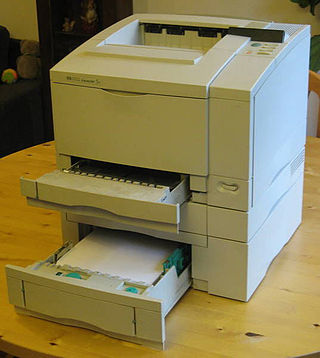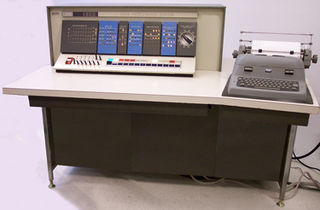
In the field of computing, a printer is considered a peripheral device that serves the purpose of creating a permanent representation of text or graphics, usually on paper. While the majority of outputs produced by printers are readable by humans, there are instances where barcode printers have found a utility beyond this traditional use. Different types of printers are available for use, including inkjet printers, thermal printers, laser printers, and 3D printers.

A punched card is a piece of card stock that stores digital data using punched holes. Punched cards were once common in data processing and the control of automated machines.

A line printer prints one entire line of text before advancing to another line. Most early line printers were impact printers.

The IBM 1620 was announced by IBM on October 21, 1959, and marketed as an inexpensive scientific computer. After a total production of about two thousand machines, it was withdrawn on November 19, 1970. Modified versions of the 1620 were used as the CPU of the IBM 1710 and IBM 1720 Industrial Process Control Systems.
The UNIVAC Solid State was a magnetic drum-based solid-state computer announced by Sperry Rand in December 1958 as a response to the IBM 650. It was one of the first computers offered for sale to be (nearly) entirely solid-state, using 700 transistors, and 3000 magnetic amplifiers (FERRACTOR) for primary logic, and 20 vacuum tubes largely for power control. It came in two versions, the Solid State 80 and the Solid State 90. In addition to the "80/90" designation, there were two variants of the Solid State – the SS I 80/90 and the SS II 80/90. The SS II series included two enhancements – the addition of 1,280 words of core memory and support for magnetic tape drives. The SS I had only the standard 5,000-word drum memory described in this article and no tape drives.

Starting at the end of the nineteenth century, well before the advent of electronic computers, data processing was performed using electromechanical machines collectively referred to as unit record equipment, electric accounting machines (EAM) or tabulating machines. Unit record machines came to be as ubiquitous in industry and government in the first two-thirds of the twentieth century as computers became in the last third. They allowed large volume, sophisticated data-processing tasks to be accomplished before electronic computers were invented and while they were still in their infancy. This data processing was accomplished by processing punched cards through various unit record machines in a carefully choreographed progression. This progression, or flow, from machine to machine was often planned and documented with detailed flowcharts that used standardized symbols for documents and the various machine functions. All but the earliest machines had high-speed mechanical feeders to process cards at rates from around 100 to 2,000 per minute, sensing punched holes with mechanical, electrical, or, later, optical sensors. The operation of many machines was directed by the use of a removable plugboard, control panel, or connection box. Initially all machines were manual or electromechanical. The first use of an electronic component was in 1937 when a photocell was used in a Social Security bill-feed machine. Electronic components were used on other machines beginning in the late 1940s.

The IBM 1403 line printer was introduced as part of the IBM 1401 computer in 1959 and had an especially long life in the IBM product line.

A keypunch is a device for precisely punching holes into stiff paper cards at specific locations as determined by keys struck by a human operator. Other devices included here for that same function include the gang punch, the pantograph punch, and the stamp. The term was also used for similar machines used by humans to transcribe data onto punched tape media.

The IBM 407 Accounting Machine, introduced in 1949, was one of a long line of IBM tabulating machines dating back to the days of Herman Hollerith. It had a card reader and printer; a summary punch could be attached. Processing was directed by a control panel.

A time clock, sometimes known as a clock card machine or punch clock or time recorder, is a device that records start and end times for hourly employees at a place of business.

The IBM 557 Alphabetic Interpreter allowed holes in punched cards to be interpreted and the punched card characters printed on any row or column, selected by a control panel. Introduced in 1954, the machine was a synchronous system where brushes would glide over a hole in a punched card and contact a brass roller thereby setting up part of a character code.

The tabulating machine was an electromechanical machine designed to assist in summarizing information stored on punched cards. Invented by Herman Hollerith, the machine was developed to help process data for the 1890 U.S. Census. Later models were widely used for business applications such as accounting and inventory control. It spawned a class of machines, known as unit record equipment, and the data processing industry.

The IBM 602 Calculating Punch, introduced in 1946, was an electromechanical calculator capable of addition, subtraction, multiplication, and division. The 602 was IBM's first machine that did division. Like other IBM calculators, it was programmed using a control panel. Input data was read from a punched card, the results could be punched in the same card or a trailing card.

A plugboard or control panel is an array of jacks or sockets into which patch cords can be inserted to complete an electrical circuit. Control panels are sometimes used to direct the operation of unit record equipment, cipher machines, and early computers. The array of holes is often contained in a flat removable panel that can be inserted into a machine and pressed against an array of contacts. This allows the machine to be quickly switched between different applications.
The IBM 101 Electronic Statistical Machine, introduced in 1952, combines in one unit the functions of sorting, counting, accumulating, balancing, editing, and printing of summaries of facts recorded in IBM cards.

From the invention of computer programming languages up to the mid-1970s, most computer programmers created, edited and stored their programs line by line on punch cards.

A computer punched card reader or just computer card reader is a computer input device used to read computer programs in either source or executable form and data from punched cards. A computer card punch is a computer output device that punches holes in cards. Sometimes computer punch card readers were combined with computer card punches and, later, other devices to form multifunction machines.

The IBM 402 and IBM 403 Accounting Machines were tabulating machines introduced by International Business Machines in the late 1940s.

The IBM 711 was a punched card reader used as a peripheral device for IBM mainframe vacuum tube computers and early transistorized computers. Announced on May 21, 1952, it was first shipped with the IBM 701. Later IBM computers that used it were the IBM 704, the IBM 709, and the transistorized IBM 7090 and 7094.

The IBM 1443 Printer is an obsolete computer line printer used in the punched card era. It was offered in three models: Models 1, 2 and N1; the last two could print up to 240 lines per minute (LPM) with a full character set.


















